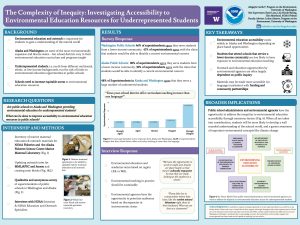The Complexity of Inequity: Investigating Accessibility to Environmental Education Resources for Underrepresented Students
Accessibility to environmental education resources for underrepresented students is oftentimes dependent on the location of the school they attend. Outright exposure to outreach, as presented by federal agencies like NOAA, also plays a role in informing the public on environmental science concepts. During my internship at NOAA Fisheries and the Alaska Fisheries Science Center Marine Mammal Laboratory, I inventoried all of the existing marine mammal education materials and content available to the public. Utilizing succinct data collection from an anonymous survey sent to all public school district superintendents in Alaska and Washington, and interviews with education and outreach specialists at NOAA, I aim to identify the limitations of environmental education engagement with the general public. There is a significant variance in the types of environmental education resources available to school districts, and a lack of material available to underserved students in low-income communities. In many cases, regardless of social demographic, little to no curriculum is offered in diverse languages outside of English. To fix the lack of accessibility, environmental agencies and school administrators have the opportunity to prioritize their audiences based on need and socioeconomic status. In our rapidly changing world, accessibility to environmental education for the coming generations is essential. When the public has the resources necessary to become educated on environmental concepts, self-awareness of individual and group impact on the environment increases. In this research study I address the ramifications of inequities in accessibility to environmental education for underrepresented students.
